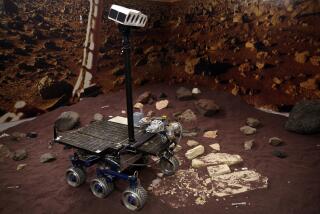Woman Found Too Small for Mir Mission
WASHINGTON â American space officials Wednesday held a news conference to show off Wendy Lawrence as the next astronaut to stay on the Mir space station and then hours later announced that she had been dropped from the mission.
National Aeronautics and Space Administration officials said they pulled Lawrence, despite a year of training, after they determined she was too small to fit into the Russian spacesuits on the troubled Mir station that are used for spacewalks.
As a result of the collision last month that crippled Mir, the space agency said it decided that the next American astronaut might have to help Russians repair damage in a spacewalk. Lawrence had not been scheduled to do any spacewalks.
But the jumbled events Wednesday raised serious questions about the apparent lack of coordination and planning at NASA, experts said.
âEven taking their story at face value, they goofed up a long time ago by not taking seriously the possibility that an American might have to do some real work up there,â said John Pike, a space expert at the Federation of American Scientists. âWhat has been revealed in the last several hours is that she should not have been on this project in the first place.â
The coordination problems with the Russians on Mir are likely to be minor compared to the much more complex task of jointly building the international space station, Pike added. The entire purpose of the Mir mission is to help American and Russian astronauts work together.
NASA officials late Wednesday said that civilian astronaut David Wolf would be substituted for Lawrence, a 38-year-old Navy commander and helicopter pilot.
At 5-foot-3, Lawrence does not fit into the Orlan spacesuits that will be used for a spacewalk to conduct emergency repairs, NASA officials said.
âWe want to have the American capable of assisting and of backing up the Russians,â said Douglas Ward, director of public affairs at the Johnson Space Center in Houston. âYou want to protect that option.â
Ward said the decision was made after meetings in Moscow between Russian officials and Frank Culbertson, NASAâs chief for the Mir space mission.
Culbertson said in a statement that the two space agencies agreed it would be better to have both Russians and the American on board capable of performing spacewalks because of the repairs needed to fix the module that was ruptured in the crash. Normally, only the two Russians are outfitted and trained to do spacewalks.
Culbertson notified Lawrence Wednesday.
Ironically, only hours earlier, Lawrence was upbeat about the challenges of the coming mission when she was presented to reporters at a press conference in Russia.
âI have a 15-year-old car back in the states, so I know what it takes to maintain something thatâs old,â Lawrence said at the cosmonaut center north of Moscow where she has been training for more than a year. âIâm ready to go.â
Lawrence was scheduled to join the Mir crew in September, when a U.S. space shuttle would rendezvous with the space station and pick up the current U.S. astronaut on board, Michael Foale. Lawrence will now be a crew member on the shuttle on that mission, NASA said.
Even with NASAâs decision to pull Lawrence, Wolf will be facing plenty of uncertainty. The final decision to put any American astronaut aboard Mir will not be made until September after a final review, the space agency said.
Earlier this month, it was decided that Foale would be made available to help the current Russian crew perform the internal spacewalk to repair Mir. But that was put off when Russian officials decided to send a fresh crew with more training on the ground to perform the complex task of rewiring the Spektr science module, which was rammed by a Russian progress supply ship last month.
Two cosmonauts, commander Anatoly Solovyev and flight engineer Pavel Vinogradov, will blast off next week from the Baikonur Cosmodrome in Kazakhstan on the repair mission.
The cosmonautsâ first task will be to enter the airless Spektr module and repair power cables cut after the collision. If they succeed, the station will have sufficient power to resume most of its scientific experiments.
Asked whether NASAâs decision in any way involved not wanting to put a woman in a risky and increasingly dangerous environment, Ward, the Johnson spokesman, said, âNo, other than a fact that women tend to be smaller than men.â
But Pike said he believes that was one of the elements in the decision by the space agency.
âI would have to believe that somebody in NASA said, âhey, we donât want to get a woman killed,â â Pike said.
The decision to pull Lawrence is particularly odd, because several years ago NASA had to pull off another astronaut after Russians complained he was too tall.
Russian space agency officials had said Lawrence was below their stringent height standards, but she was cleared to return last summer when the requirements were modified.
Times staff writer Richard Paddock contributed to this story.
More to Read
Sign up for Essential California
The most important California stories and recommendations in your inbox every morning.
You may occasionally receive promotional content from the Los Angeles Times.










